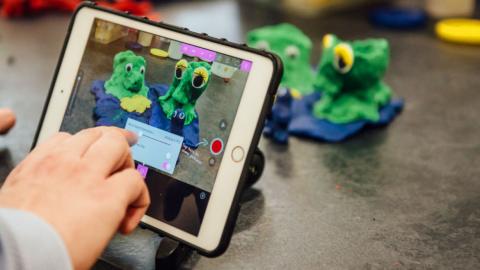Music Videos Are Like Short Films: Featuring BTS, Troye Sivan, and Florence + the Machine
Share with friends
Music’s just another way to tell a story.
Lyrics, rhythm, and music. It’s amazing how these come together and are able to touch each of us in such a personal way. We all have a favorite song; they make us sing along, dance, or feel understood. Now add a visual—a concert. Your favorite band mere feet in front of you. Their lyrics ring in your ears, and the bass vibrates in your chest. A song, their single plays, and you think back to the first day you heard it on the radio, or saw the music video on Youtube.
If you’re anything like me, when you’re watching said music videos you might expect more than a band playing their instruments intercut with actors making out in the background. The influx of social media in music has made many musicians think outside the box when it comes to presenting their singles to an audience. They’ve hired legitimate directors to put a face to their music. This has helped filmmakers find a new avenue in showcasing their abilities on a small, but extremely relative scale. Everyone who loves music will watch these videos. But how many of them are truly trying to say something?
Recently an influx of artists ranging from all genres of music (from rock to k-pop) have created cinematic music videos to propel singles, or simply their band to a broader audience. These videos, some coming in parts, others in the length of short films, not only showcase the artist’s music, but an intricate story complete with character, climax, and resolution.
K-pop band BTS (Bangtan Boys), a South Korean boy band, in 2015 began releasing a series of music videos featuring songs I Need U, Run, a special prologue video featuring Butterfly, and finally ending the series earlier this year with Young Forever. Using heavy symbolism, each music video tells one part of an overarching story that has gotten BTS fans all over the world creating long, complex theories in regards to what, exactly the story is about. Though there are some differences in the theories, the main consensus is that it revolves around the tragic tale of a boy (member Taehyung, aka “V”) with a difficult home life who commits suicide in front of his group of six friends, and the aftermath it causes. The event tears apart the remaining members of the group a little at a time, each of them following Tae’s path down a road of destruction in which they each ultimately wind up joining their friend in the afterlife. Young Forever, the final MV in the series, is the reunion of the group, the video ending with all of them patiently waiting for Taehyung to join them before wandering off towards whatever comes next (which may be addressed in a brand new series of short films that just began getting released this week).
In 2015, South African born Australian singer and actor, Troye Sivan, released the first of a three-part video titled: Blue Neighborhood. The first part, Wild, is the setup of the story to come, and at first looks similar to many music videos on the Internet with young actors playing the roles of Troye and the best friend he holds desperately onto throughout the entirety of the video, a boyish friendship that is to reveal itself to have grown into something much more by the last second of the film. The story continues in Fools, where the friend’s father finds out about his son’s relationship and beats him into denying his love for Troye’s character. The images switching between the boys from childhood--a much simpler, pleasant time--to the present of turmoil and heartache is truly maturely done, and ultimately ends with a preview of the third video as seen through a laptop screen. The full film concludes with Talk Me Down, a true cultivation of the three MVs with images from each resurrecting in the video, filmed mostly in a cemetery as a funeral party gathers around the grave of Troye’s friend’s father. He holds hands with a girlfriend and Troye’s character looks on, remembering them as boys playing, and then as older lovers. Now, all they have is a short moment of embrace before the boy’s girlfriend takes him away. The use of flashback is a heavy element in these three parts, and an effective tool in truly showing the turmoil in the main character. It is an overall story that bluntly tackles the issues of gay romances and the consequences that can come about from the prejudices that still exist today.
The latest endeavor comes from Florence + the Machine, a female-fronted band from London. In 2015, before the release of the band’s third album How Big, How Blue, How Beautiful, they released their first single in February 2015. The video for What Kind of Man would be the first chapter of nine, each continuing the story of “The Odyssey,” each video feeling very similar in voice and pacing, setting and character. While it wasn’t clear at the time, all these videos would fit together to create an epic journey of one woman.
While the previous examples used their music to make mini films, these series of videos feel different with nine singles involved and put together in one forty-eight minute film. The nine released singles are: What Kind of Man, How Big, How Blue, How Beautiful, St. Jude, Ship to Wreck, Queen of Peace, Long & Lost, Mother, Delilah, and Third Eye.
Lead singer and songwriter Florence Welch, and director Vincent Hancock set about to capture the shattering of a relationship falling deeper than heartbreak, and in the end is about the battle going on inside of us. What Kind of Man begins in dialogue between a couple (Welch) in a car that eventually crashes. It’s from this crash that Welch is sent on a journey of pain, longing, letting go, destruction, self-discovery, and eventual acceptance. The videos take place in various locations including London, Scotland, Los Angeles, and Mexico, and are described by Welch as a map of the emotional turbulence she went through before writing the album. The videos connect from one song to the next by the constant first person perspective from Welch, some connecting scenes that have been shot strictly for “The Odyssey,” including two scenes of Welch singing the songs How Big, How Blue, How Beautiful and Mother in acapella. The choreography is full of chaotic movements including violent gestures and even a doppelganger of Welch who pops up in multiple segments. Parts of Welch’s home were used to film Ship to Wreck, including having some of her real family members at the dinner table as she trashes it. The story comes to a climax in Delilah, and finds resolution in Third Eye with Welch repeating the lyrics “I’m the same, I’m the same, I’m trying to change…” while being led on stage to a cheering audience.
With this recent influx of longer, more intricate music videos, one can’t help but wonder if this much effort and detail will become the norm. As it stands, newer Kpop group Monsta X released Part 1 of their own music video miniseries, with Part 2 due to be released some time in the upcoming months. It’s a surprising turn for a part of the music industry that was once thought would become obsolete with the dissolve of channels such as MTV and VH1. Thankfully, with platforms such as YouTube and Facebook allowing for the resurgence of genuine artistry, solo singers and bands are given the chance to show us their music while also granting filmmakers the opportunity to give us a cinematic experience to compliment said music, truly bringing the story behind each song to life in an intricate way that all audiences can enjoy.
Here’s hoping we’ll see more of this plotted, musically enhanced storytelling in the years to come.




